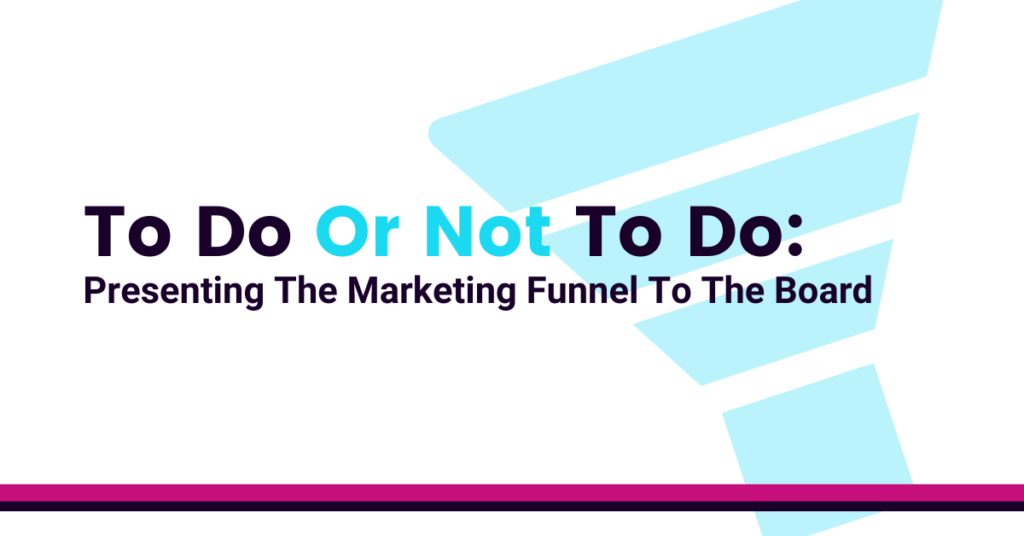

The Power of the Marketing Funnel... When Done Right.
Ohhh how I love a good marketing & sales funnel or waterfall, depending on your preferred nomenclature. Full of promise, with stages that neatly separate themselves based on behavior, lead score and team ownership. Conversion rates along the side provide a nice level of detail into Go-To-Market efficiency. For those familiar with a lead cohort, you can learn a lot by looking at it but the question here is do you bring it to the board meeting with you?
Before we answer that, let’s first discuss a few key funnel related topics and define what I mean by a lead cohort:
- How to build one that provides valuable insight
- What the funnel helps us answer
- Decisions that can be made by looking at a mature cohort
Definition of Lead Cohort: When we talk about lead cohorts, we’re talking about a group of leads that are grouped together for the purpose of analyzing that group as one. Whenever I talk about lead cohorts, I’m typically speaking of them being grouped by time. I.e., the group of leads we acquired in Q1 of 2022. They all become part of the Q1 cohort.
And with that, on to some fun funnel related topics…
Building a Marketing → Sales Funnel That Provides Valuable Insight
The concept is pretty straightforward. Leads → MQL’s → SQL’s → QSO’s → Closed Won or some variation, each a subset of the stages before it. Said differently, all SQL’s were at one point MQL’s and Leads before that, doing so maintains the math so that you can correctly calculate conversion rates from one stage to the next.
Now, stating those stages is one thing but to get this right, you actually have to define them, in detail. I’ve always seen it done best when marketing & sales get in a room together and go through stage by stage making sure each agrees with how a stage is being defined and who is responsible for which stages. Take the time to dive into detail here, it may seem exhaustive and “too in the weeds” but it’ll be time well spent. Once finalized, communicate it with everyone on the team.
The second step to making sure you have a funnel that will offer the team value is to make sure you’ve aligned your systems so that you can track against it accurately. One might think that your marketing platforms are built to do this out of the box. Unfortunately, it’s not quite that simple and will take some marketing ops work to get it right and then ongoing maintenance to keep it up to date.
What The Funnel Helps Us Answer
Like all reporting, it’s important to recognize what the marketing → sales funnel can tell us AND it’s equally important to understand what it cannot.
Three things that a properly tracked cohort can tell us includes:
- Return on marketing investment, as a whole, by channel or by program
- Stage by stage conversion rates
- Choke points and breakdowns in efficiency
Decisions that Can be Made by Looking at a Mature Cohort
Above we talked about some of the items that a marketing → sales funnel can tell us. One of the questions I have received often over the course of my career is, “how is this actionable”. And ultimately, that is what a board of directors truly cares about. And the answer is, there are a number of ways this view can be actionable.
The first is that if you have taken the time to tightly define the stages of your funnel and you are able to identify the key choke points in the funnel, you can address what’s happening in those stages. Take for example a situation that occurred in my past where our Marketing Qualified Lead → Sales Accepted Lead (we used this stage as our meeting stage) was extremely low. We were acquiring thousands of new leads each quarter and only moving a small percentage into a sales meeting. With that information, we took a closer look at our BDR connect rates & activity metrics and decided to add more BDR support to get more leads engaged and into our next stage. Over time we saw this conversion rate increase and our funnel become more efficient overall.
Next up, if you’ve captured and tracked leads correctly over time, you can start to get a good understanding of how long it takes for a cohort to completely mature. In the same example from my past, each quarter cohort of leads would take about 6 quarters to fully mature. That meant that the programs we ran in Q1 would continue to impact the business over the next year and a half. With that information, we were able to assess whether the investments we were making today were paying back at a high enough level over time to justify the expense in the first place.
Finally, as you get more and more advanced at tracking these lead cohorts and understanding which quarters are most impacted by marketing investment, you can begin to layer in some predictability into the business that is guaranteed to make any board very happy. A past example here comes from the same as the one mentioned above. Each quarter of programs and activity would take 6 quarters to mature. We also knew that ~20% of the revenue that would come from that quarter’s funnel would happen in the same quarter. Another 30% would come in the next quarter and then another 20% the quarter after that. It starts to form a nice bell curve of sorts. As you start to stack last quarter on top of this quarter, you begin to be able to predict what is going to happen in the future, based on past and present efforts. It’s an incredibly freeing feeling if and when you get here.
OK, I buried the lead but I am hoping you hung in there with me because as much as it’s important to answer “should I bring the funnel to the board” it’s important to understand the mechanics behind it and why they may or may not like it.
My answer to this question is yes, the marketing → funnel is an important component to bring to the board and to present on regularly. Before I go any further I will caution that showing this funnel alone is not enough. It’s going to lead to someone in the room asking “is this good or is this bad?” and “is this helping us hit our goals or not?” Boards are predictable, each slide needs to give them insight into the health of the business OR identify areas where they can help.
Alright back to the presentation. The funnel is a starting point, it tells the board a couple important things.
- It shows extreme alignment between sales & marketing. While I may move it into the appendix after the first meeting, having a slide that shows the definition of each stage and who is responsible for what will illustrate just how linked the marketing and sales motion are for the organization.
- It shows the board that you were able to take the corporate revenue goal and turn it into actionable targets. Leads, Meetings, Opps, Closed Won, each a subset of the other, each a target that teams can understand and march against.
If the above is well articulated, it sets up the rest of the story. Both marketing and sales need marketing to invest in programs. And by building the marketing → sales funnel, you can display an approach to a marketing budget request that is based on real numbers. It’s amazing the impact this has on confidence for those thinking about the financial wellbeing of the organization.
From here, it’s important to move into some reporting that brings some of the trends and in-quarter impact to life so that they can see that not only do we have a good grasp on how we need to go execute, we also have a good grasp on measuring the execution as it happens to see where we are to goal.
BONUS TIP: If you have a long sales cycle and with it a long lead to opp cycle, the funnel can be misleading and it’s important that you recognize that and plan accordingly in how you present it. If it takes 6 months for a lead to move through to a closed won deal then you’ll need to shift your perspective back and illustrate how your efforts in the second half of the year will impact the first half of the next. So if it’s October and you’re just starting planning for the upcoming year, you are already too late. Don’t know where to start? Start here.
4AM is here to help give you the confidence and data to back it up so that board meetings are no longer intimidating, but FUN!
We’d love to connect!
Interested in trying the 4AM Platform for free? Create an account and let us know what you think!


